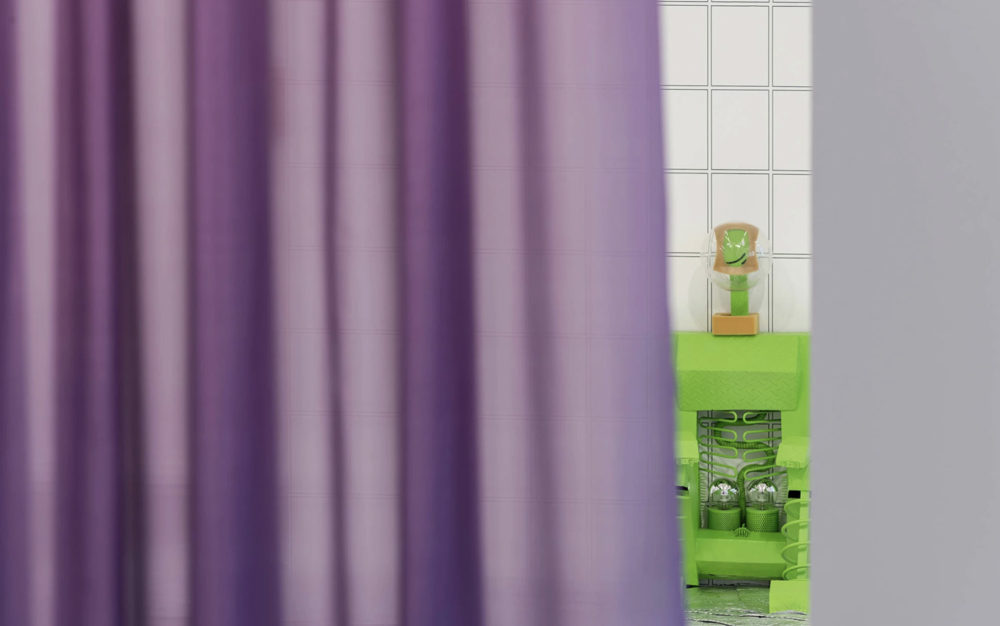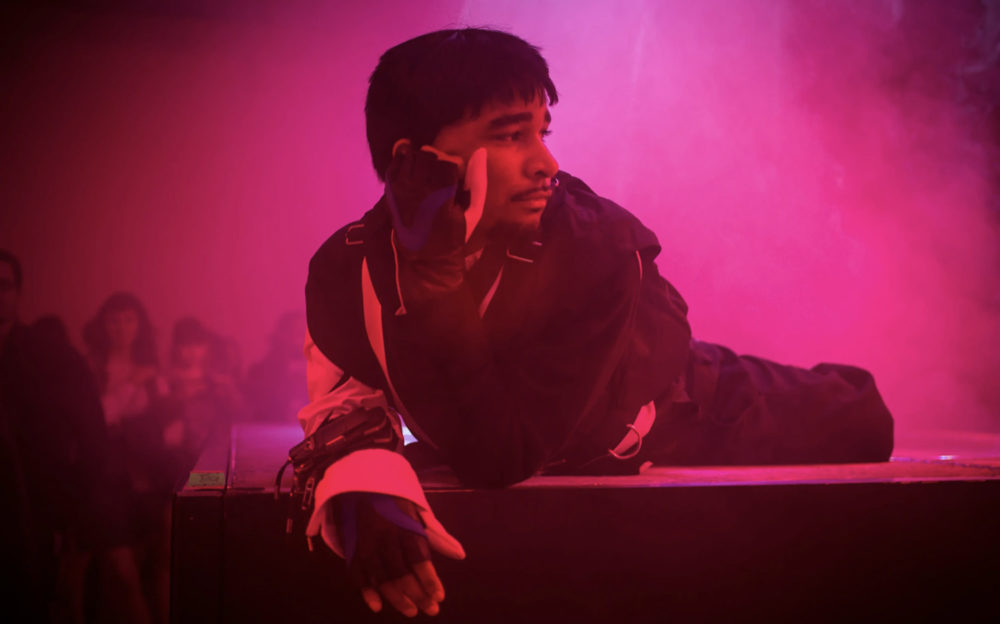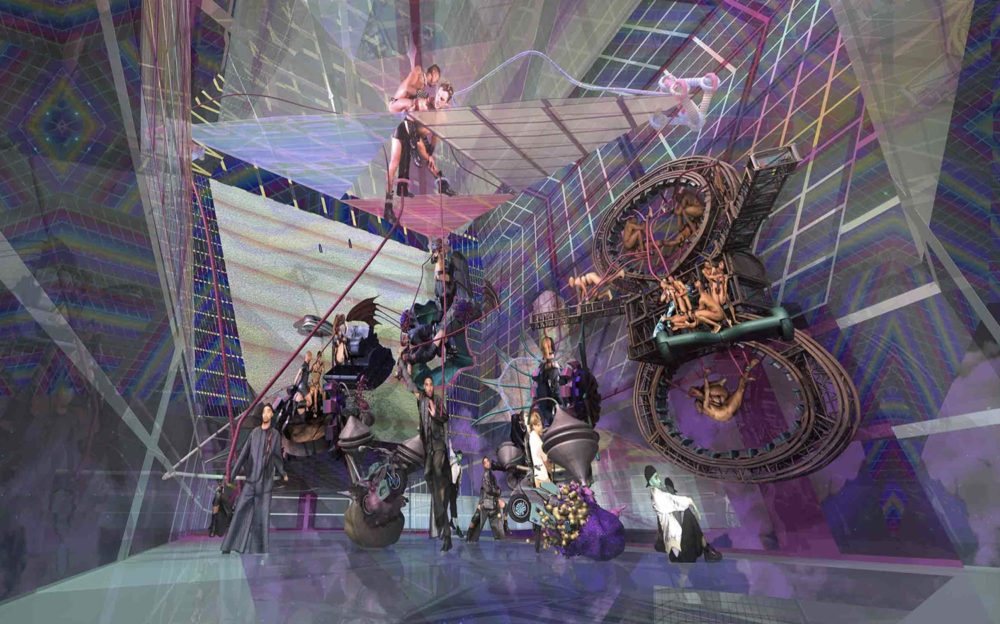
- Source: Art Basel
- Author: Kathy Noble
- Date: June 01, 2018
- Format: DIGITAL
Performing the future: how two young artists use robots and VR to explore alternative realities
Flaka Haliti and Jacolby Satterwhite talk to Kathy Noble about their bold new projects for Art Basel’s Statements sector
Flaka Haliti and Jacolby Satterwhite reimagine the social systems of the world that structure our lives. Satterwhite takes his childhood’s domestic setting to build futuristic virtual landscapes. In his hands, the familiar environment becomes a stage on which to perform scenes of queer sadomasochistic role-play, which he sees as a metaphor for late capitalist domination and subjugation. Haliti considers the performance of national politics and identity within Europe by exploring the Nato intervention in Kosovo, her country of origin. Both use elements of the industrial and technological realms to create alternative spaces – for people, objects, and materials to perform in – in order to ask what other potential, more radical, futures might be possible.
Haliti’s installation Its urgency got lost in reverse (while being in constant delay) #2 (2018), presented by the Munich gallery Deborah Schamoni in Art Basel’s Statements sector, houses a robot created from recycled Nato materials from a KFOR military camp in Kosovo (KFOR, the Kosovo Force, is a multinational peacekeeping force that currently comprises 20 Nato countries and eight non-Nato nations). The awkward turquoise robot lies on a floor of silver isolation mats, in a futuristic space delimited by a painted grid. The piece is the second in a series of four, in which each new machine connects to the last. ‘Each installation is a mood, or scenography,’ says the Munich-based artist. ‘The stationary robot is stuck in a past tense. It’s a lazy sculpture – it’s standing there, but doesn’t know what to do.’

Flaka Haliti, Here – Or Rather There, Is Over There (installation view), Kunsthaus Hamburg 2018. Courtesy of the artist, Deborah Schamoni, Munich, and LambdaLambdaLambda, Pristina. Photo by: Michael Pfisterer.
This feeling of apathy holds particular significance for Haliti, who talks about ‘the nightmare of being stuck in constant delay’. The artist refers to the ongoing presence of Nato in Kosovo as a form of neocolonialism: Nato escalated the conflict in 1999 by bombing Yugoslavia, and nearly 20 years later, it is still present in the country. ‘I wanted to subvert this situation,’ she says. ‘The robot is waiting for orders, stuck in time.’ The robot here echoes retired soldiers who, although no longer active, are marked by their military past – waiting for orders that never materialize.
Haliti was born in 1982 in what was then Yugoslavia. She studied art at the University of Pristina and at the Städelschule in Frankfurt before representing Kosovo in the Venice Biennale in 2015. Kosovo’s history is also very much her own. When she began researching Nato’s presence, Haliti stumbled upon two markets in Pristina that sold materials from a former Nato camp. At the time, she was reading sociologist Avery Gordon’s theories of hauntology, in which she states that everything is haunted by the specter of something. ‘These markets are huge. If you don’t know the context, you wouldn’t realize that the objects come from a Nato military camp,’ says Haliti. ‘They look like random, secondhand objects. At that moment, Gordon’s concept of everything being haunted struck me heavily – these objects are obviously haunted by their history. [Cultural theorist] José Esteban Muñoz also speaks of the future potentiality of places, or objects, that are present but do not exist in the present tense. The Nato objects are present, but they don’t exist in a present tense, so how do you make these objects exist in the present tense?’
Haliti’s installation’s title Its urgency got lost in reverse (while being in constant delay) #2 speaks to the haunted object, to the object lost in time, and to the materials that form the robot, that now have no purpose. By repurposing these objects, Haliti offers them a potential new future, determined by the artwork’s locations, and the desires the audience projects onto it. The humanoid machine is a character on a stage, lying in this faux digital space, as if waiting to be activated, to live its new life. ‘With Kosovo, with Nato, with the United Nations, or the European Union, we are in a moment when we are all trying to understand what the future might be,’ says Haliti. ‘Through art, we can try to understand this potential future,’ she adds.‘It’s not there yet, but it’s in a process of becoming.’ Haliti’s robot offers a vessel with which to reconsider history and to imagine the future.
Similarly, Satterwhite’s virtual spaces are stages for performances rooted in the past to offer alternative futures. In these, joyful catharsis and repetitive movements mingle to play out narratives of contemporary capitalism, seen through the lens of queer subjectivity. The New York-based artist’s installation Avenue B (2018) features virtual reality, 3D-printed sculptures, ephemera, drawing, and wallpaper. It is the second installment in a new body of work, the first of which is entitled Blessed Avenue (2018).

Jacolby Satterwhite performing En Plein Air: Music of Objective Romance, 2017 as SFMOMA. Courtesy of the artist and Morán Morán, Los Angeles.
Satterwhite was born in South Carolina, USA, in 1986. He studied at Maryland Institute College of Art and the Skowhegan School of Painting & Sculpture before receiving an MFA from the University of Pennsylvania. Best known for the elaborate virtual worlds he constructs, Satterwhite is an avid collaborator, staging performers, friends, and other artists in the digital spaces he conjures up. For Avenue B, presented by the LA-based gallery Morán Morán , also in the Statements sector, elements from the piece’s digital environment are 3D-printed, adding a physical dimension. These sculptures place the viewer squarely within Satterwhite’s imagination. ‘It emulates a domestic setting, which is the genesis of my work,’ says the artist. ‘My mother worked on the blueprints of idealistic homes and the objects contained in them. And as my practice is animism-orientated philosophically, I wanted to continue to use the aesthetic of the home, and the materials it contains, but more specifically, to consider the notion of the home-entertainment center – to create a universe centralized around these ideas.’
Satterwhite’s mother, Patricia Satterwhite, was an artist who lived with schizophrenia. ‘No one took her seriously, but I tried to be an artist so that I could help her,’ he says. ‘She had a delusion of grandeur, which was wonderful and exciting for a child’s imagination. My mother was my playmate, to an extreme degree.’ Avenue B began with 155 a cappella songs recorded on cassette tapes by Patricia in the 1990s while in a psychiatric hospital and at home. With these, Satterwhite composed an album in collaboration with Nick Weiss, a Brooklyn-based musician from the electronic-music duo Teengirl Fantasy. Satterwhite then began working on a virtual landscape inspired by series of drawings of everyday objects (a hammer, a pulley, a ladder, a dog leash) made by his mother, which also became a starting point for choreographic actions. These were developed by shooting himself perform to camera in front of a green screen. ‘It relates to early work by Bruce Nauman, or Yvonne Rainer – [an aesthetic] of super-pared-down movement,’ says Satterwhite. ‘As I record my physical movement, this gestates into imagery and animation, which I then abstract. Via the traced drawings, it turns into a Hieronymus Bosch-like space, or a Piero della Francesca-like tableau.’

Jacolby Satterwhite, Blessed Avenue (2018). Courtesy of the artist and Morán Morán, Los Angeles.
The artist incorporated other performers in various ways: some were shot at parties at which friends and people he admires perform freely in front of a green screen; others were asked to enact specific gestures, or to emulate choreographers such as Anne Teresa De Keersmaeker or William Forsythe. The performers were then transposed into Satterwhite’s virtual landscape, a luminous, sci-fi factory-meets-spaceship, in which skeins of corridors, platforms, and pods unspool to form a visceral scene radiating hues of pink, purple, and green. In this dizzying kaleidoscope, the dancers and characters – including Satterwhite himself – are copied repeatedly, presented alongside one another to form a mass choreography for the digital age.
Satterwhite’s scenography is sublimely surreal, yet the performers’ actions are rooted in the politics of both private and public realms. His true subject is the friction between the personal and the public. Feminist and queer theory have long argued for the politicization of the private sphere, yet this feels ever more urgent in the digital age. ‘I need an incongruent dichotomy between two different realms to realign the virtual and the real, the public and the private, and the work slaves and master space that exists in the virtual world,’ he says. ‘It’s two dystopian scenarios put together, to get the viewer to switch between psychological spaces, to give them this general idea of schizophrenic capitalism. The sadist and the masochist are akin to labor and capitalism, the construction of these consumers, the maintenance of site, the maintenance of public, and the maintenance of private.’ Like Haliti’s discarded Nato materials, Patricia’s drawings of domestic appliances are haunted symbols, and a point of departure for her son’s new world. If our past writes our future, both artists ask, how can we actively disrupt that past in the present, to become aware of our behaviors and to reconfigure our systems?

